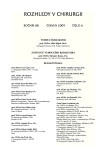Vertical Rectus Abdominis Myocutaneus Flap for the Closure of Perineal Wound after Abdominoperineal Resection of the Rectum
Authors:
J. Örhalmi 1; B. Vřeský 2; P. Holéczy 1; S. Jackanin 1; P. Biath 1
Authors‘ workplace:
Vítkovická Nemocnice a. s., Centrum péče o zažívací trakt, Chirurgické oddělení
primář: doc. MUDr. Pavol Holéczy, CSc.
1; Fakultní Nemocnice Ostrava-Poruba, Centrum plastické chirurgie a chirurgie ruky
přednosta: MUDr. Bronislav Vřeský
2
Published in:
Rozhl. Chir., 2009, roč. 88, č. 6, s. 314-316.
Category:
Monothematic special - Original
Overview
Introduction:
A major source of morbidity after abdominoperineal resection (APR) after neoadjuvant external beam pelvic radiation are perineal wound complications. Wound complications are common for 25–66% of patients overall. There are many of procedures provided to reconstruct the perineal defect after APR e.g. primary closure, secondary closure, superior gluteal artery flap and vertical rectus abdominus myocutaneous (VRAM) flap. Our purpose was to describe the effect of VRAM flap on reconstruction of perineal wound.
VRAM flaps are ideally suited to bring nonirradiated tissue into defect associated with radical surgical extirpation procedures and irradiated fields. This flap, distally based in the deep inferior epigastric vessels, provides several distinct advantages. It is well perfused by the robust dominant pedicle and the deep inferior epigastric artery and vein. In addition, this flap provides adequate muscle bulk to obliterate pelvic dead space. The skin island can be used for resurfacing the perineal region, including the vaginal wall, and provides versatility for all patterns of resection.
Conclusion:
VRAM flap provides very good aesthetic and functional results, is technically relatively simple and radically decreases wound complications rate. The additional possibility is pull-though the flap transpelvically intraabdominally instead of pull-through via subcutaneous channel, especially with females.
Key words:
abdominoperineal resection – perineal wound – vertical rectus abdominis flap
Sources
1. Christian, C. K., Kwaan, M. R. Risk factors for perineal wound complication following abdominoperineal resection, Dis. Colon Rectum, 2005, 48, 1, s. 43–48.
2. Bullard, K. M., Truder, J. L. Primary perineal wound closure after preoperative radiotherapy and abdominoperineal resection has a high incidence of wound failure. Dis. Colon Rectum, 2005, 48, 3, s. 438-443.
3. Ferenschild, F. T., Vermaas, M. Salvage abdominoperineal resection and perineal wound healing in local recurrent or persistent anal cancer. World J. Surg., 2005, 29, s. 1452–1457.
4. Chessin. D. B., Hartley J. Rectus Flap Reconstruction Decreases Perineal Wound Complications After Pelvic Chemoradiation and Surgery: A Cohort Study. Annals of Surgical Oncology, 2005, 12, s. 104–110.
5. Buchel, E. W. Pelvic Reconstruction Using Vertical Rectus Abdominis Musculocutaneous Flaps. Annals of Plastic Surgery, 2004, 52, s. 22–26.
6. Papaconstantinou, H. T. Salvage abdominperineal resection after failed Nigro protocol: modest success,major morbidity. Colorectal Dis., 2006, Feb, 8(2), s. 124–129.
Labels
Surgery Orthopaedics Trauma surgeryArticle was published in
Perspectives in Surgery

2009 Issue 6
Most read in this issue
- Endoscopic Diagnostics and Treatment of Flat Intestinal Lesions
- Chemotherapy and Biological Treatment in the Complex Management of Large Intestinal and Rectal Carcinomas. When, Why, How?
- Antibiotic Prophylaxis in Colorectal Surgery
- Enteral Fistula as a Postoperative Complication – A Case Report
